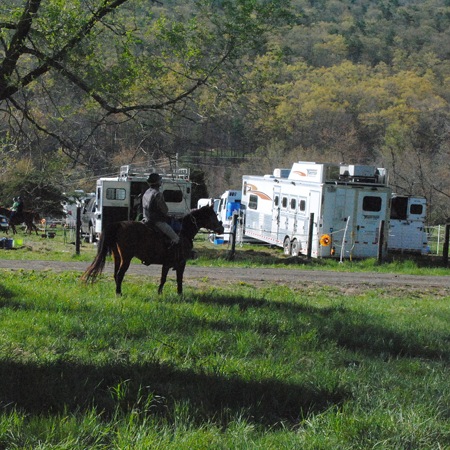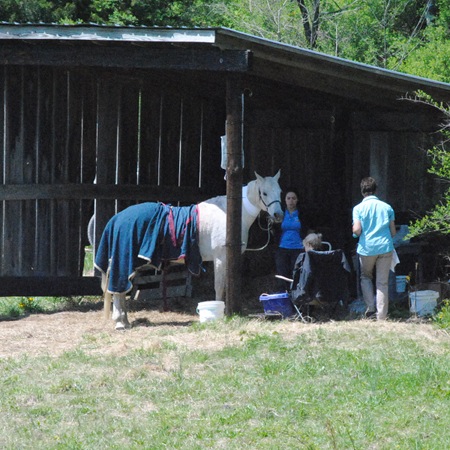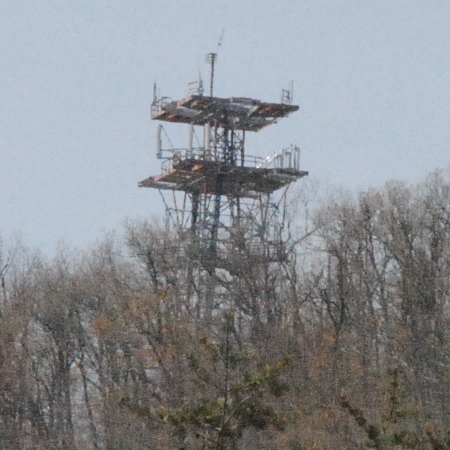Public Service
If you desire a way to provide a service to the public using your radio investment and communication skills, you may fulfill a need with trail oriented activities such as Horse Endurance Riding.
Horse endurance riding events have trail rides from 30 to 100 miles in total length. The ones I assist have trails out and back setting the maximum distance between any two points at 50 miles. In reality the radio distances are a bit shorter, but certainly tens of miles over mountains and ridges.
This long distance and rough terrain are key differences between this and other shorter events like marathons, bike rides, etc.
Mountains are the norm for horse trail riding
Horse Endurance rides often occur deep in mountainous regions where line-of-sight radios are sporadic at best and often useless. The remoteness often places parts of the trail beyond the reach of cell phones and amateur radio repeaters.
The trails often skirt along ridge lines providing good radio links to neighboring valleys, but these events value communication between various checkpoints down in the valleys.
The makes for a challenging task quite suitable for Amateur radio.

The above map outlines the problem for any communications… mountains. The I-81 cell phone corridor is two ridge-lines east and is well served by cell phone towers. However, cell phone service was only marginal at the Base Camp station for AT&T service and nonexistent for other carriers. Cell phones were useless everywhere else.
The above links A, B and C connect Base Camp (NE), Vet Check (Middle) and Gate & Go (SW). The link colors indicate the “simulated” relative strengths of the links where green is good, red is bad, and yellow in between. Radio Mobile Deluxe provided the calculations and generated the map from elevation data. Please note, however, the algorithm in Radio Mobile (Longley-Rice) throws a warning #3 on every calculation due to the terrain. The following three figures illustrate…



Beware, the above figures exaggerate the vertical dimensions and do so differently depending on the particular circumstances. The notes help to understand the significant angles and the distances between stations. Since Radio Mobile shows warning #3 we really can’t rely on the path loss calculations, but we can still gain a good awareness of the task using the above terrain awareness.
The fellow in charge of our radio group has been working this event for approximately 30 years and has tried just about everything including:
- Portable repeater atop a ridge – good for the local area, but not a solution for the stations beyond the next ridge or two.
- 60m NVIS – actually works quite well unless there is too much atmospheric noise.
- 2m FM Vertical Pol. – Works remarkable well over ridge lines if the link angles to the ridge lines are under 10 degrees.
- 6m FM Vertical Pol. – Modest results.
The consistent winner before now is 2m FM using vertical polarization. We brought the 2m gear again this time, but added 6m SSB horizontal polarized antennas to the mix.
6 meters the “magic band” for mountain radio links
During pre-planning weeks before, I was assigned to base camp. Plus we all decided to give 6m SSB a try. I noticed the two other stations were almost the same bearing, southwest, suggesting a beam would be very helpful. I added my 6m LFA Yagi along with my portable 2m vertical to the gear list.

The beam points SW towards the Vet Check and Gate & Go stations manned by two other hams.
While the ham drove towards the end of Link A, he maintained communications via his mobile 6m rig and vertical polarity antenna. We thought the ridge lines might disrupt the polarization and mix things up, but it was evident we were cross pol the whole way. I heard a distinct 10 Hz or so flutter on the 6m signals. The operator said this was most likely reflections from passing aircraft.
Upon reaching the end of Link A a simple 6m horizontal dipole was strung in the trees. A quick test between Base and Gate & Go (Link A) was simply amazing, with strong S7 signals both ways between us. No flutter. No fading. There was nothing, but strong signals over two ridges with the SW station down in a very low location. Amazing.
Shortly thereafter the operator arrived at Vet Check, set up a 6m dipole oriented North-South (the supports were limited). A quick test of Link B revealed perfect copy both ways.
Then the hams tested the 6m link between them via Link C. They could barely hear each other despite the shorter distance. No matter in this case since both had solid copy with me at base camp where I served as relay.
MURS radios play a key part
Keeping in mind the goal is to provide communications via any means possible, the use of the license free MURS radio service is a great idea. The HT shown below is an older example of a MURS radio. These VHF radios have similar propagation to the terrain tolerant 2m ham band. Being license free means you can hand them to any volunteer. This is especially useful when Drag Riders (volunteers on horses that follow the pack ensuring no one is left behind) carry these radios and report to Net Control at base camp.

FRS and GMRS radios are also options, but the VHF MURS signals carry better and longer in the mountains. One disadvantage is MURS radios are more expensive due, in part, to their smaller market share.
Hams on Horseback
This Virginia Horse Endurance Ride has rider volunteers carrying ham licenses. This event is the only reason some of them have an amateur radio license. They carry the usual 2m/440 HTs and stick to our 2m FM frequency to coordinate with Base Camp. Some carry both a ham HT and a MURS radio to maintain contact with other non-ham volunteers.
3rd party traffic
As a radio volunteer much of the traffic is simply status and news on the progress of the riders. Other times there are situations where time counts. Very often you will hand the microphone over to a distraught horse owner at one end and a veterinarian at the other. These volunteer vets provide the advice and help and do so more quickly with the help of our radio links.
Our group facilitated no fewer than three such discussions during this weekend’s event.
Net Control
This is like a mini-field-day or VHF Rover setup. That’s yours truly manning the Blazer tailgate.
Lessons Learned
Helping with events like this always highlights points well worth remembering for next time. Here are some of my thoughts…
- Move the 2m vertical antenna to above the 6m beam on the mast.
- Create an external antenna for the MURS radio.
- Use separate radios for 6m SSB and 2m FM to monitor both simultaneously.
- Ensure the base camp station has an appropriate abundance of antenna gain to compensate for the low gain mobiles and even lower gain HTs.
A few observations on the use of 6m in the above three terrain situations is worth noting.
- Link A and C both have at least one fairly steep angle to defeat. Link A is about twice as long as Link C, but Link A was astounding better than C.
- Radio Mobile is great tool, but throws up its hands, as it should, in terrain like this. It is still a perfect tool to critically analyze the terrain between two points both in sideview elevation and birds’ eye map views.
- While we can’t press a button to get a go-nogo answer about a link from Radio Mobile in this terrain, it can, along with the observations above plus future tests, provide a skilled volunteer a much better guess.
6M LFA Yagi Beam met expectations
This was the first opportunity to test the new 6m LFA Yagi-Uda beam antenna. For this deployment no balun was used for reasons stated in another post about the LFA.
Near the end of the day, the operator at the end of Link A agreed to stay on station for a few minutes while I swung the beam around with the rope. This is hardly an accurate measurement, but all I sought to verify was decreased signal to the sides and the rear. Results include:
- Beam pointing at other station – Signal Strength about S7
- Beam pointing 90 degrees from other station – Signal Strength about S1
- Beam pointing away from other station – Signal Strength gone and audio barely audible
Subjective as this test was, it was very evident the beam’s behavior matched the design goals. Whereas S7 signals were heard from the end of Link A with the antenna on axis, the signals dropped to S1 or so on the side and faded away to almost nothing on the back end. Awesome… totally awesome.
The LFA design from Justin Johnson (G0KSC) appears to be a very good approach when great F/B is your goal. The full-wave loop’s inherent self-balance precludes the need for a balun for all, but the most noise sensitive situations. The LFA design targets maximum noise reduction, but the fortunate byproduct is an antenna that is pretty much a throw-and-go assembly. Thank you Justin Johnson for your pioneering work on this well refined design.
Other Pics
One thing about volunteering at events like this is all the new things you will see. Horses obviously…
The middle picture shows a horse that had a condition call “Tied Up” which I later learned is pretty serious. Behind the post you can see the largest IV bag I’ve ever seen.
The horse on the right was placed in this fenced area while his owner assisted another horse. He did not like that one bit and made sure everyone knew it by prancing and making noise. Beautiful horse though.
Dogs
The most well behaved dogs I have ever seen were aplenty at this event.
Microwave Tower
Hammy eyes can spot things others could care less about. Here we have a decommissioned microwave relay tower from the old AT&T system allegedly.
Is it a rich Prepper or a poor Senator
Off on a distant mountain top was this beautiful home with a wind turbine.
Nice QTH.
Conclusion
Volunteerism is good for the soul and we Amateur Radio operators have a role to play in difficult communication situations such as the Horse Endurance Ride above. No-cell-phone conditions like this are the last bastion where our Amateur radio frequencies have some use.
In this particular case, 6m SSB using one beam and two modest dipoles worked fantastic even when one station was practically down in a ditch.
EmComm operators take note… preparing for emergencies is a good idea, but realize while you wait for the rare emergency where Amateur Radio might play a helpful role, other non-emergency volunteer opportunities await.













Great writeup John, and interesting to know how well 6m worked in this situation.